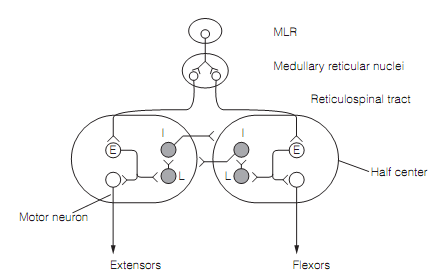Central pattern generators
Locomotion is movement from place to place. There are several modes of locomotion (example, swimming, stepping, and flying) but all depend on cycles of muscle activity, alternate flexion and extension of every limb, however the gait or manner of locomotion (example, walking or running) based on the speed. The step adopted is the one that minimizes the energy expenditure for that speed.
In human stepping each leg have a stance phase, whenever extensors are most active, and a swing phase, whenever the flexors are the most active. The similar series in the opposite leg is out of phase, however during walking there is a short overlap of the stance phase in both legs. As the speed raises the stance phase shortens until there is no overlap and the switch to running takes place.
The basic rhythms of locomotor activity are generated by central pattern generators (CPGs), networks of inter-neurons in spinal cord which produce the accurately timed series of motor neuron activation without the requirement for sensory input. Each and every limb has an array of CPGs. Thus each CPG is an oscillator with two half centers, one driving flexors, and the other driving extensors, with reciprocal connections among them. Each half center generates rhythmic bursts of action potentials which are terminated in a time and manner determined by the intrinsic excitable properties of its constituent neurons. The cessation of firing of single half center releases its opposite number from reciprocal inhibition, permitting it to fire a burst. In this manner burst firing alternates among the two half centers.
CPGs have been studied in the lamprey, a primitive vertebrate, and it is probable that mammalian CPGs use similar principles as shown in figure below. The depolarization of excitatory (E) cells in one half centers activates their NMDA receptors. The resulting calcium influx prolongs the depolarization therefore the E cell fires a burst of action potentials. The burst firing of E cells stimulates the motor neurons. Two features of the circuit permit it to flip-flop among bursting of first one half cells then the other. At first, the E cells stimulate L cells that inhibit the I neurons responsible for the reciprocal inhibition. This dis-inhibits the opposed half center. Secondly, the E cell burst ends as the calcium activates KCa channels, permitting K+ efflux and hyperpolarization.
Locomotor activity is started by activity in the mesencephalic locomotor area (MLR) that projects to reticular nuclei in the medulla as shown in figure. Axons from here run in the reticulospinal tracts to the spinal cord. These reticular nuclei are excitatory, discharging glutamate to generate a large depolarization of the CPG neurons that then generate oscillating output for as long as the MLR input continues. The CPGs are interconnected therefore the timing of events in all limbs is coordinated. The fundamental locomotor rhythms of the CPGs are extensively altered by the supraspinal motor systems.

Figure: A simplified hypothetical model of a central pattern generator (CPG) based on studies of the lamprey. Each of the neuron symbols represents numerous cells. The excitatory (E) cells use glutamate and show burst firing in response to supraspinal input. The inhibitory neurons are glycinergic; contralaterally projecting interneuron (I) inhibit the opposite half center. Here, L=lateral interneuron; and MLR=mesencephalic locomotor region.